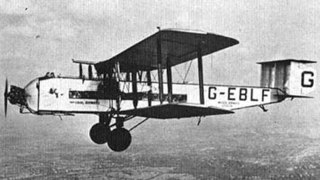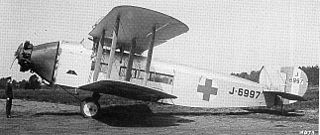
The Vickers VC10 is a mid-sized, narrow-body long-range British jet airliner designed and built by Vickers-Armstrongs (Aircraft) Ltd and first flown at Brooklands, Surrey, in 1962. The VC10 is often compared to the larger Soviet Ilyushin Il-62, the two types being the only airliners to use a rear-engined quad layout, while the smaller business jet Lockheed JetStar also has this engine arrangement.

The Vickers Vimy was a British heavy bomber aircraft developed and manufactured by Vickers Limited. Developed during the latter stages of the First World War to equip the Royal Flying Corps (RFC), the Vimy was designed by Rex Pierson, Vickers' chief designer.

The de Havilland Express, also known as the de Havilland D.H.86, was a four-engined passenger aircraft manufactured by the de Havilland Aircraft Company between 1934 and 1937.

The Vickers VC.1 Viking is a British twin-engine short-range airliner derived from the Vickers Wellington bomber and built by Vickers-Armstrongs Limited at Brooklands near Weybridge in Surrey. After the Second World War, the Viking was an important airliner with British airlines, pending the development of turboprop aircraft like the Viscount. An experimental airframe was fitted with Rolls-Royce Nene turbojets and first flown in 1948 as the world's first pure jet transport aircraft. Military developments were the Vickers Valetta and the Vickers Varsity.

The Vickers Viking was a British single-engine amphibious aircraft designed for military use shortly after World War I. Later versions of the aircraft were known as the Vickers Vulture and Vickers Vanellus.

The Armstrong Whitworth Argosy was a three-engine biplane airliner designed and produced by the British aircraft manufacturer Armstrong Whitworth Aircraft. It was the company's first airliner.

The Vickers Type 56 Victoria was a British biplane freighter and troop transport aircraft used by the Royal Air Force. The Victoria flew for the first time in 1922 and was selected for production over the Armstrong Whitworth Awana.

The Vickers Virginia was a biplane heavy bomber of the British Royal Air Force, developed from the Vickers Vimy.

The Airco DH.4 is a British two-seat biplane day bomber of the First World War. It was designed by Geoffrey de Havilland for Airco, and was the first British two-seat light day-bomber capable of defending itself.

The Handley Page W.8, W.9 and W.10 were British two- and three-engine medium-range biplane airliners designed and built by Handley Page.

The de Havilland DH.61 Giant Moth was a 1920s British large single-engined biplane transport built by de Havilland at Stag Lane Aerodrome, Edgware. Intended primarily for use in Australia, a number were also shipped to Canada.

The de Havilland DH.50 was a 1920s British large single-engined biplane transport built by de Havilland at Stag Lane Aerodrome, Edgware, and licence-built in Australia, Belgium, and Czechoslovakia.

The de Havilland DH.66 Hercules was a British 1920s seven-passenger, trimotor airliner built by de Havilland Aircraft Company. With the Hercules, Imperial Airways took over responsibility for the airmail service from the Royal Air Force, which had been operating the obsolete Airco DH.10 Amiens.

The Airco DH.16 was a British four-seat commercial biplane of the 1910s designed by Geoffrey de Havilland, the chief designer at Airco.
Instone Air Line was an early British airline from 1919 to 1924. Along with other private airlines of the time, it was absorbed into Imperial Airways.

The de Havilland DH.18 was a single-engined British biplane transport aircraft of the 1920s built by de Havilland.

The de Havilland DH.34 was a single engined British biplane airliner built by the de Havilland Aircraft Company in the 1920s. 12 were built, with the DH.34 serving with Imperial Airways and its predecessors for several years.

The Bristol Ten-seater and Bristol Brandon were British single-engine biplane transport aircraft built by the Bristol Aeroplane Company in the early 1920s. Only three were built, two of which were used as civil transports and one of which served with the Royal Air Force.

The Vickers Vanguard was a 1920s British airliner developed by Vickers Limited from the Victoria.
British Air Transport – The Pioneering Days 1919–1934 is an 8.44-metre (27.7 ft)-long mural by William Kempster depicting, from left to right, a chronological sequence of events in the history of British aviation on the London to Paris route starting on the left with Hounslow Heath Aerodrome in 1919 and finishing on the right at Croydon Aerodrome in 1931. The most recent aircraft shown is the Short L.17 Scylla of 1934.



















